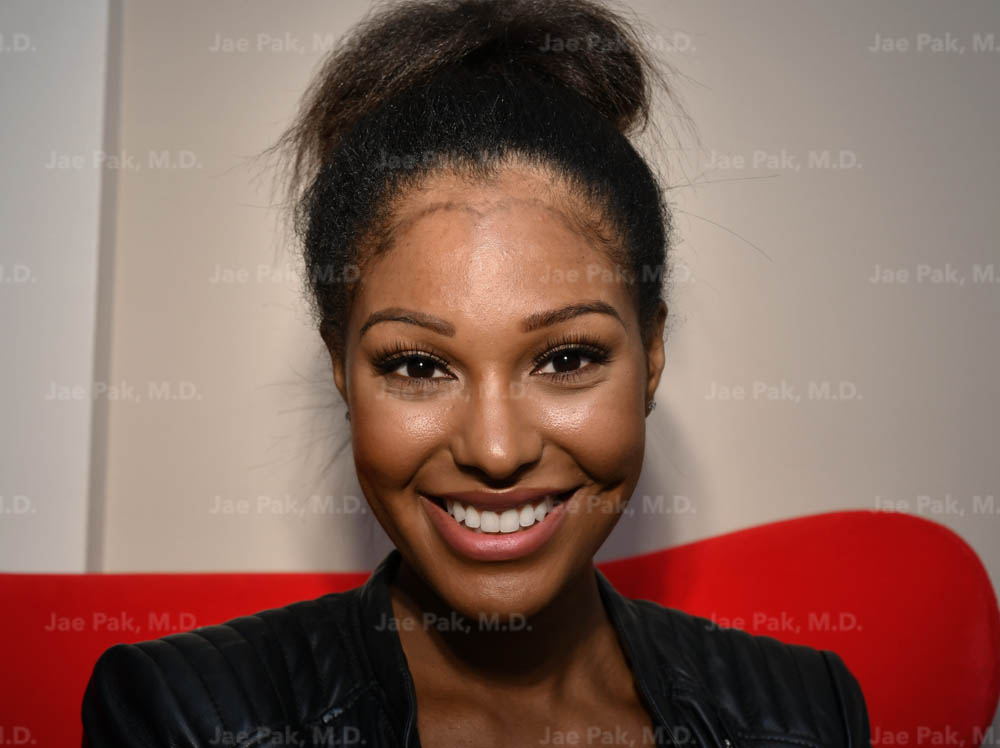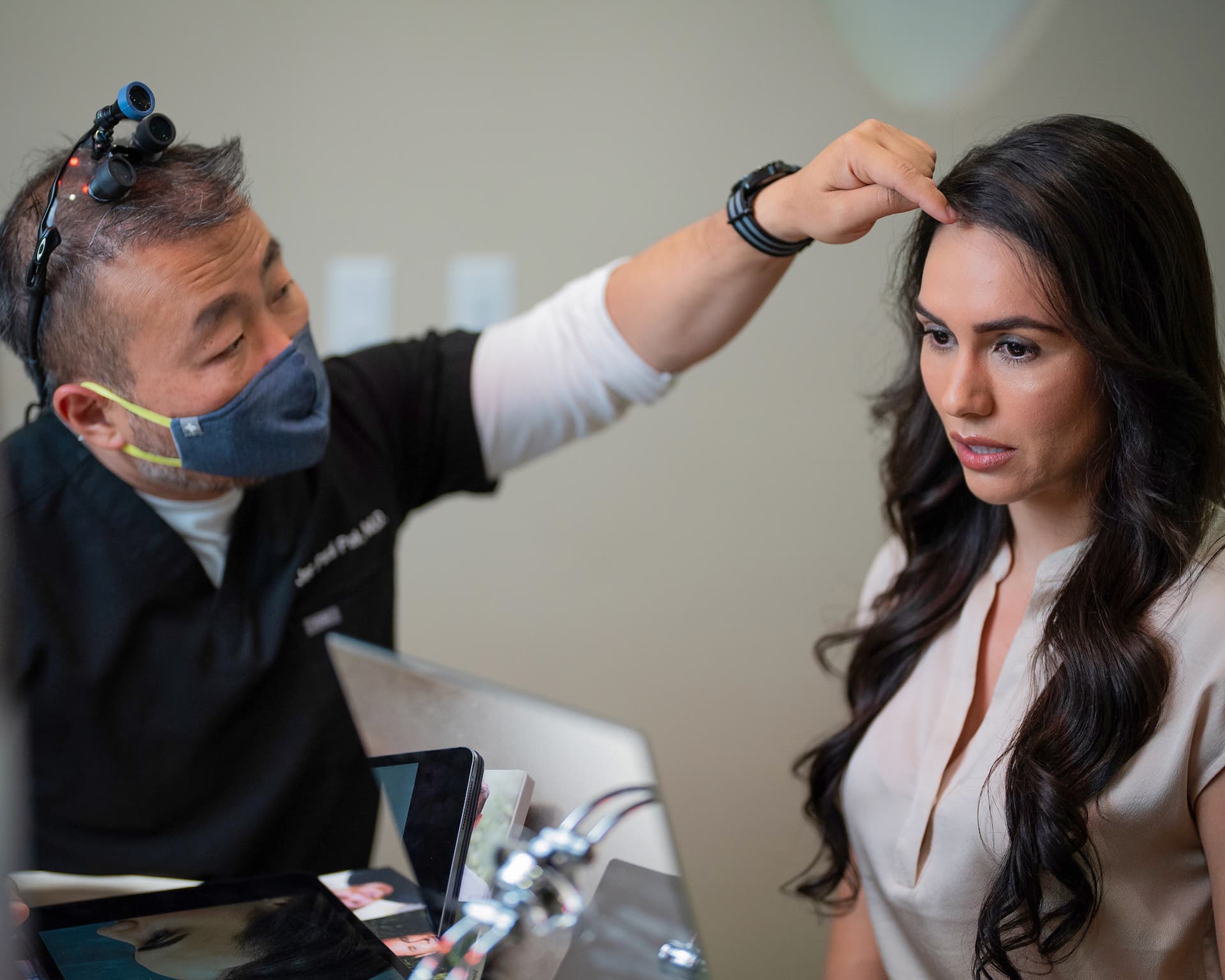
Actual Patient of Jae Pak, M.D. before Hairline Surgery
A healthy and attractive head of hair is essential to everyone, but for women, in particular, a receding hairline can be a major cause of concern.
We tend to think of male pattern balding as the main issue when considering hair loss, but women are impacted as well.
However, the process happens somewhat differently for women with various causes and patterns that don’t reflect typical male pattern hair loss.
That’s why at Jae Pak MD, we take a different approach to understanding and addressing receding hairlines for women and why we’re exploring the topic in-depth in this article.
Here’s everything you need to know about the causes of receding hairline in women, from the most common reasons to the full range of treatments and procedures available.
What exactly do we mean by receding hairline in women? Generally, this is the tendency for hair on the scalp to lose density and thickness over time, particularly in the head’s frontal area and the temples.
Despite mainly being a male issue, women around the world also experience receding hairlines more often than you may think. Here are the basics about receding hairlines in women and facts to consider before we explore the various causes and solutions.
Receding hairlines impact less than 40 percent of the female population under the age of 40, making it less universal than male pattern balding – but not necessarily rare.
In young women, receding hairlines are uncommon, affecting only a small fraction of the population, but the likelihood increases as women reach middle age and beyond.
Still, by the time women reach advanced age, there’s only about a 12% chance that receding hairline will be a significant issue.
As we’ll discover, many things can be done to help slow or even reverse this trend.
When it comes to hair loss, we are our own worst critics and tend to notice small signs early on when detecting a receding hairline.
All women can expect some degree of shedding – between 50 to 150 hairs daily – as a normal part of life. However, if shedding increases beyond this typical rate, it may cause concern.
Women who may be genetically predisposed to hair loss will want to keep a close eye on the shedding rate as they age, tracking the amount of hair they see in the shower drain, on the pillow, or in the sink as they style their hair.
A receding hairline may take time to notice, and the position of a hairline may be one of the last things to change as female hair loss occurs over time. More commonly, women will see thinning in the central “part” of the hair along the scalp or notice density loss on the side of the head and the temples.
Hair may also lose some of its natural volume and strength with age, which can indicate that a receding hairline may occur sooner than later. Even if you notice just a slight change in the quality or quantity of hair on the scalp, this could be a sign that it’s time to take steps to address receding hairline before the effects set in.
While men typically refer to the Norwood scale to determine their degree of pattern balding on the scalp, we use the Ludwig scale to classify female pattern baldness.
Comparing the image progression of these two scales shows us some fundamental differences between male and female pattern hair loss. It can be a valuable tool to diagnose issues and map out solutions.
The most evident difference between the Norwood and Ludwig scales is the hairline itself, which remains intact much longer for women than men, even in severe cases.
Women will often experience diffuse thinning on the scalp’s center – or vertex – before seeing the hairline move back and expose more of the forehead. Men, on the other hand, will often start to see their hairlines recede before noticing any severe thinning or patchiness on the top of the head.
This tells us that the causes of hair loss between men and women are fundamentally different and will inform our decision-making process when it comes time to formulate solutions for female hair loss of all types.
There are several potential causes for receding hairline in women, requiring a different course of action to address. Here are the top causes and what they mean for potential fixes in the future.
Androgenetic Alopecia describes a genetically inherited trait for hair life cycles to slow and stop as someone ages. We often use the term interchangeably with male pattern balding, but it can also be applied to hair loss in women.
The main difference here is that androgenetic alopecia in men is thought to result from high concentrations of DHT – a byproduct of testosterone – as it interacts with hair in some regions of the scalp.
Female androgenetic alopecia differs because DHT does not appear to be the main driver of life cycle interruption, miniaturization, or diminishing hair quality over time.
Instead, experts believe the leading cause of female hair loss to be gradual changes in a woman’s hormonal profile as she ages, which can be accelerated or mitigated by environmental factors.
This is why we don’t tend to see severe hair loss before menopause and why women typically have less trouble reversing these trends with various treatments and therapeutics.
Genetics aside, health and lifestyle factors cannot be ignored when it comes to a receding hairline for women of any other type of female hair loss. These can include everything from how a woman styles her hair to products, such as dryers, flattening irons, dyes, or other tools.
Diet, exercise, stress, and other lifestyle choices also come into play here and can impact the health and longevity of a woman’s hair as she ages.
While some degree of genetic thinning may be unavoidable for some women at a certain age, proper haircare and a healthy lifestyle can make a big difference in maintaining hair, especially on the front of the scalp and hairline.
In rare cases, women may endure rapid and unexpected hair loss due to health conditions, like alopecia areata or hormonal problems resulting from major fluctuations from other treatments, trauma, or life events.
These unusual circumstances impact a small percentage of the population, but all factors must be considered when identifying problems and solutions.
This is just one key reason why it’s so important that women start a dialogue with a proven hair restoration professional when tackling the issue of receding hairline or any form of pattern hair loss.
Any number of non-typical root causes may be at work. A generalist plastic surgeon or dermatologist does not typically have the range of experience and knowledge to create a custom strategy to address the issues.

In terms of solutions, there are many ways that women can go about restoring their hairline, especially if the pattern is detected early on.
Check out these three main categories that specialists recommend for women addressing a receding hairline, ranging from low to high cost and commitment.
Making lifestyle changes should always be the first recommended course of action for women looking to improve their hair.
Simply living a more natural and healthy life will allow hair to reach its potential without disruptions from hormones, stress, and unwanted environmental factors.
Furthermore, natural remedies like essential oils, supplements like collagen and biotin, and other effective products are widely available with low risk and potential upside.
Hair loss doctors are likely to prescribe topical Minoxidil for women experiencing receding hairline or even moderate thinning on the scalp. Minoxidil is a vasodilator and has shown positive results in clinical trials.
Other therapeutics may be recommended for women to slow or reverse hair loss patterns, ranging from low-level red-light therapy to platelet-rich plasma, microchanneling of the scalp, and even stem cell treatments.
More women seek a permanent fix for receding hairline, which can be accomplished through surgical means via standard transplantation methods or hairline lowering. These techniques allow surgeons to harvest strong, healthy hair from a donor area at the back of the head, then precisely implant the follicles along the hairline to restore shape and density.
Alternatively, forehead lowering procedures involve removing a linear strip of skin in front of the hairline and bringing the two skin segments together to shorten the forehead.
A receding hairline can be a distressing development for anyone at any age. Women, in particular, may be concerned and confused when observing a receding hairline since it tends to be far less common in the female population than in men.
Thankfully, our understanding of female hair loss has made great progress in recent years, along with our ability to craft custom solutions that address the issue at multiple levels.
If you’re ready to get serious about fixing your receding hairline, or you’re simply interested in taking preventive measures for a lifetime of healthy hair, now is the time.
Contact Dr. Jae Pak and set up a consultation to get your hair on the right track.
Sources:
Classifications of Patterned Hair Loss | NIH
Female pattern hair loss: Current treatment concepts | PMC
A female patient with a receding hairline | NIH
Female Pattern Hair Loss: a clinical and pathophysiological review | PMC
Minoxidil and its use in hair disorders: a review | PMC

Speak with Jae Pak, M.D. today!
Request a Consultation